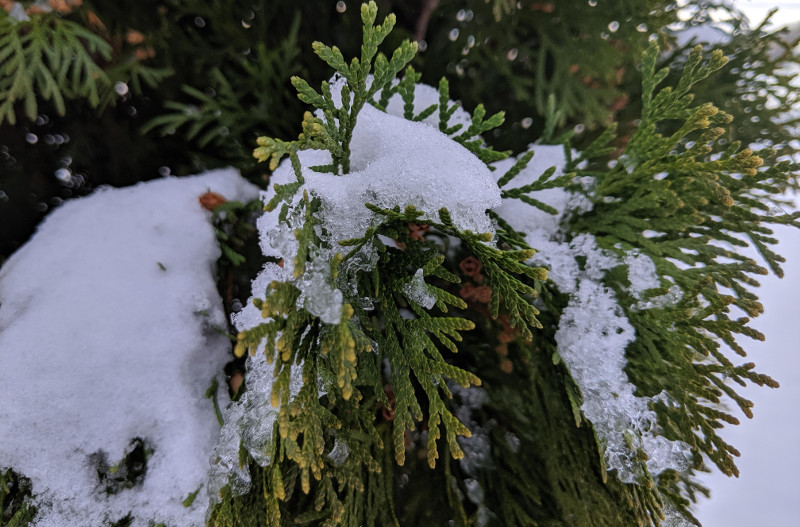Arborvitae (Thuja) are versatile, easy-care evergreen trees in the Cupressus family. With a natural conical shape, they make great hedges, wind breaks, or privacy trees.
Arborvitae are hardy in USDA zones 3-7, making them easy to overwinter in many parts of the country. The rich green scaly foliage offers wonderful texture in the winter garden.

Snow and ice can cause multi-stemmed trees, especially when younger, to splay apart and break, causing permanent damage. This can be prevented in fall by tying the stems together with twine.
If you live in deer country, you may want to protect them from hungry critters with burlap wrapped around and stapled to a circle of stakes. For large trees, run the burlap to 8 feet high.
Wrapping in burlap this way can also help you overwinter Arborvitae if your garden is colder than zone 3.
Stress from drought, high winds, or extra cold temperatures can cause desiccation or browning. The best prevention for this is to keep your plant well-watered before the cold weather, mulch with a layer up to four inches, and wrap if necessary in your climate.
Cutting Back Arborvitae for Winter
Because the foliage is evergreen, it’s best to save any needed pruning for your Arborvitae until the growing season of spring through summer. If you do see any die-back from winter stress, wait until spring to trim it.

Arborvitae Winter Care in Pots
Soil helps insulate plants in winter, so small pots will be at greater risk in freezing temperatures. Consider mulching the pot with at least four inches of mulch, for instance bark chips, or covering with a layer of fern trimmings or light branches (not leaves that will mat down).
A persistent snowpack will also act to keep the roots warm.
Positioning the pot against a wall will add further reflected warmth from the house wall, and if under an eave will protect from excess moisture in rainy climates.
Another option to keep the plant from freezing is wrapping the pot in chicken wire and filling the space between the pot and wire with fallen leaves.
Watering Arborvitae in Winter
Prepare for winter by watering regularly all the way through fall. When a freeze is in the forecast, we recommend watering thoroughly beforehand, to give the roots the best protection from freezing damage.
For arborvitae in pots, you’ll want to find a balance between keeping the pot watered by not overly so, so watch your weather conditions. Water between snows, but water less often in regular rain. The best measure is testing the soil with a trowel – see if it is dry or moist. If dry, water right away.

Steps To Care For Arborvitae in Winter
Depending on your climate, you may want to protect your plant in zones 3 or colder, or if you have deer.
Step 1 Water consistently from spring through autumn, and again in winter before freezing temperatures are forecast.
Step 2 Tie up young stems if your area is snowy.
Step 3 Consider wrapping with burlap to keep warm in zones 3 or colder, or to protect from deer.
Step 4 Mulch plants to a depth of 4 inches.
Step 5 Protect pots if necessary in your climate with a ring of chicken wire filled with fallen leaves
Step 6 Do not prune until spring or summer
 |
Author Erica Browne Grivas - Published 10-08-2021 |
